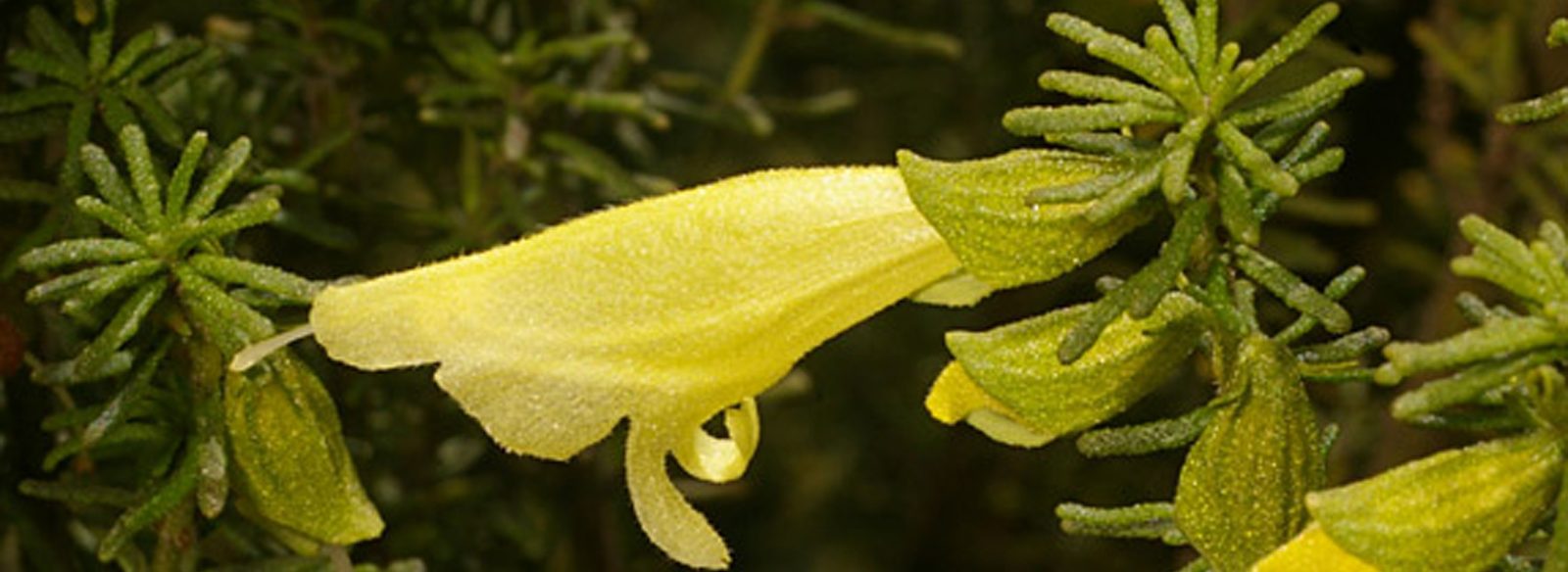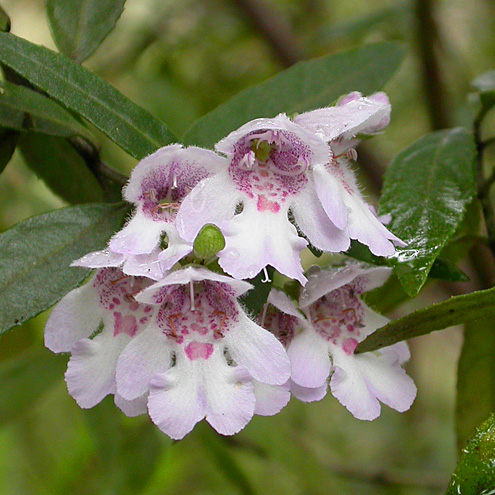Mint Bush Family – Background
Introduction
The mint bush family, known as the Lamiaceae (formerly the Labiateae) is widespread throughout the world and contains a number of well-known, commercially cultivated plants which are used in cooking and for perfumes. These include:
- Basil (Ocimum basilicum)
- Culinary mints (Mentha species)
- Lavender (Lavendula angustifolia)
- Majoram and Oregano (Origanum species)
- Rosemary (Rosmarinus officinalis)
- Sage (Salvia officinalis)
- Thyme (Thymus species)
Worldwide, the family compries over 200 genera and over 3000 species. There are about 20 Australian genera in the Lamiaceae, the best known of which are:
- Ajuga; about 45 species worldwide, two native to Australia
- Chloanthes; 4 species, all native to Australia
- Faradaya; about 18 species worldwide, one native to Australia
- Hemiandra; about 7 species, all confined to Australia
- Hemigenia; about 40 species, all confined to Australia
- Mentha; about 20 species worldwide, about 6 native to Australia
- Plectanthus; occurs in Africa, Asia and 15 species in Australia
- Prostanthera; about 60-70 species, all confined to Australia
- Scutellaria; about 300 species worldwide, 2 native to Australia
- Westringia; about 23 species, all confined to Australia
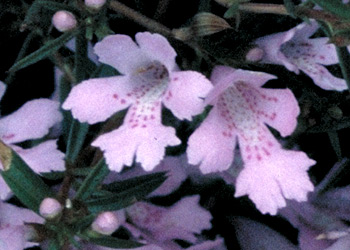 |
| Hemiandra pungens, showing the 2- lobed upper lip and the 3-lobed lower lip of the Lamiaceae Photo: Brian Walters |
The most commonly cultivated Australian members of the family are Prostanthera (known as “mint bushes”), Westringia and (occasionally) Hemiandra.
Characteristics
A characteristic of members of the Lamiaceae is a “two-lipped corolla” – in which the five petals are united into two upper lobes and three lower lobes giving the appearance of two lips. Although not a unique characteristic (eg. Eremophila in the Scrophulariaceae also have two lips), it is one of the easiest features to help the average person in identification. The two-lipped feature gave rise to the previous name for the family, the Labiateae (from Latin, labellum, a lip).
The two most popular genera in cultivation, Prostanthera and Westringia can be distinguished by the shape of the calyx at the base of the flower. In Prostanthera, the calyx is two-lipped while in Westringia the calyx is divided into 5 segments.
Members of the Lamiaceae are generally herbs and small to medium shrubs. In Australia, the only species which reaches small tree proportions is the Victorian Christmas tree (Prostanthera lasianthos) which can attain 8-9 metres in Gippsland forests.
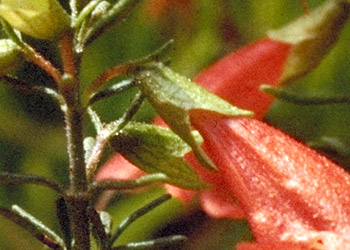 |
| Prostanthera aspalathoides, showing the 2-lipped calyx (the green structure at the base of the flower) Photo: Brian Walters |
Many members of the family have aromatic foliage due to the presence of volatile oils and it is these oils which give exotic members of the family their characteristic taste and aroma which is so valuable in cooking. In Australia, the genus with the most prounced aromatic foliage is Prostanthera (although not all species are aromatic). The foliage of many prostantheras emits a pleasant aroma when crushed or brushed against. In the Australian bush the aroma of mint bushes can be very pronounced following rain.
Despite the relatively high oil content of the foliage of many Australian members of the family, little use has been made of either the leaves or the oil. Some species are used by bush foods enthusiasts as flavourings in cooking in the same way as their exotic counterparts (eg. Mentha australis, Prostanthera rotundifolia).
In nature, members of the family can be found in a wide range of habitats….. coastal cliffs (Westringia fruticosa), semi alpine areas (Prostanthera monticola), semi arid areas (Hemiandra gardneri), rainforests (Prostanthera lasianthos). Some, like the Austral bugle (Ajuga australis), span a range of habitats over a wide area. Most species, however, are found as part of the understorey in open forests and woodlands.
Mint Bush Family – Propagation
Introduction
Members of the mint bush family are usually grown from cuttings as many of the most horticulturally desirable species strike readily.
Seed
The ease of propagation from seed varies considerably between the different genera within the family. In some cases germination occurs readily (eg. Ajuga, Plectanthus) but in other cases can be unreliable (eg. Prostanthera, Westringia, Hemiandra) and fresh seed usually gives the best results in these cases.
Pretreatment of seed prior to sowing to improve germination is not normally beneficial with members of this family. However, a method that has been successful for at least some species is the use of smoke or “smoked water” as a pretreatment. This has been successful in the germination of species of Hemigena and may have practical application for the home propagator for this and other genera in the Lamiaceae. Further information on this procedure is available in the article Smoke Stimulates the Germination of Many Western Australian Plants (see information under the “Further Information” tab) and from the Regen 2000 web site.
Cuttings
Most shrubby members of the Lamiaceae strike readily from cuttings using hardened, current season’s growth. Cuttings about 75-100 mm in length with the leaves carefully removed from the lower two-thirds seem to be satisfactory. Treating the lower centimetre with a “root promoting” hormone both seems to improve the success rate but is often unnecessary.
Members of this family serve as a good introduction to those starting out in propagation from cuttings as success rates are usually high.
Division
Some members of the family (eg. Mentha) produce suckers from their root systems. These can be cut from the parent plant (ideally retaining some of the roots) and potted into individual containers. If placed in a sheltered location and kept moist, these should develop quickly into new plants.
Grafting
Considerable work has been carried out on grafting with Prostanthera to improve the hardiness of the genus in areas where they are difficult to grow.
Most species of Prostanthera are compatible with a root stock of Westringia fruticosa, a very reliable plant suited to many districts. Grafting of Prostanthera species to W.fruticosa is not difficult and, like cuttings, is a good project for those starting out in grafting. A number of other westringias (eg. the cultivar “Wynyabbie Gem”) have also been successfully used as root stocks for Prostanthera species.
There are some prostantheras which are not compatible with W.fruticosa. These include P.aspalathoides and P.calycina. These can be grafted using the “nurse graft” technique which is explained (along with basic grafting methods) in the article Grafting Prostantheras under the “Propagation-Grafting” tab.
Little or no work has been done on grafting of other genera of the Lamiaceae. There is plentty of scope for experimentation for the keen amateur, particularly in improving the hardiness of species in the genus Hemiandra (eg. H.gardneri, H.pungens).
General Propagation
Further details on general plant propagation can be found at the Society’s Plant Propagation Pages.
Grafting Prostanthera
Robert Miller
The following article has been reproduced from Lasianthos, Number 1 (1993), a special publication of the Prostanthera and Westringia Study Group.
Introduction
The most important thing to remember about grafting is, it’s easy.
I can hear some of you saying, “It is, if you know how!” or “…, if you’ve got the touch!”. Well the answer is, it truly is easy, if a little attention to detail and the right after care is provided.
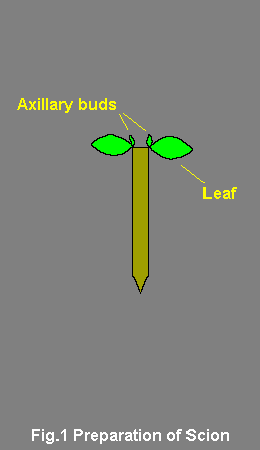 |
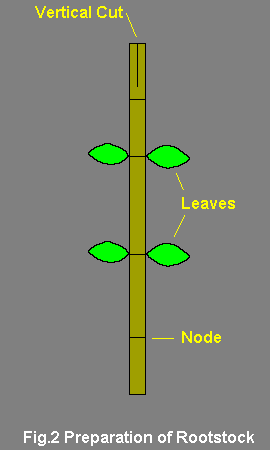 |
There are many types of grafts, some simple and others which appear to be contrived to baffle the layman and torture the would-be horticulture student. Hence most people, amateur and professional alike, have “put off” grafting for life! In my opinion, difficult acts of carpentry have little place in grafting Prostanthera. I see no advantage in mastering such techniques, especially for use on thin diameter material, as the claims of superior strength or better cambial contact have little or no merit in such instances. I do not believe that a graft that is only 0.5-2 cm long and from 2-5 mm in diameter can have greater strength depending upon the grafting technique used, especially once the plant has reached maturity. More importantly, it is the compatibility of the rootstock with the scion and the selection of the wood (stage of growth) of both the scion material and the rootstock which is important.
The two rootstocks I use most frequently are Prostanthera nivea (Eugowra form) and Westringia fruticosa. These two rootstocks will give good success in most soil types, however other species may give as good or possibly superior success in your conditions. Try using as a rootstock the most reliable Westringia or Prostanthera in your area.
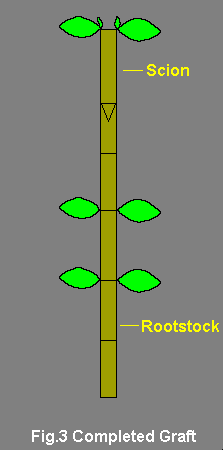
My preferred technique is the cutting graft (Fig 2), where both the scion (Fig.1) and the rootstock cutting are done simultaneously using the top wedge graft (Fig 3). I have developed this technique as it is relatively quick, easy and takes up little room. Admittedly, it may often be more successful grafting onto struck rootstock, however this often requires timing (ensuring the plants are at the same growth phase) and more room to often achieve the same results. The cutting graft technique eliminates the need for having a supply of struck rootstock on hand and is very useful for the unexpected arrival of material.
With difficult species it is normally easier and more successful to try grafting than to put in cuttings with limited material. I back both “horses in the race” if sufficient material is available.
The Grafting Details
Ideally, the right wood for the scion is vigorous, healthy soft-wood material that is not in flower (this is not often possible from the wild, especially when collecting colour forms) which has dormant or very small axillary shoots. This is prepared as one would prepare a cutting. Normally, with larger leafed species, only one set of leaves are left on the scion but with smaller sclerophyllous species more leaves may be able to be left on depending on the condition of the scion material.
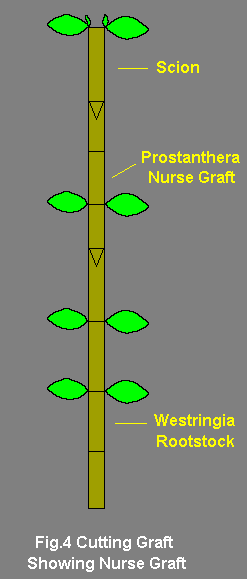
The rootstock should be semi-hardwood at the base and firm softwood at top (without signs of pith in the centre of the branchlet). This is often obtained by using vigorous shoots (eg· after hard pruning). Removing the appropriate amount off the soft tip (normally 1-4 nodes from the tip) will give a firm point, but still one that has not developed pith, to do your vertical cut. I try to achieve a rootstock cutting that has two nodal points at the top with the leaves removed, then two nodal points with leaves left on and then two nodal points with leaves removed at the bottom (Fig 2). It is advantageous if the rootstock and the scion are of the same diameter as this reduces the need to match cambial tissue. Your success will be further enhanced if the nodal portions of both the scion and the rootstock are aligned, as a thicker band of cambial tissue occurs in this region and, in theory, this should result in greater success. This is a simple procedure if the cuts are made in the appropriate positions (Fig 3).
Not all species of Prostanthera will graft successfully onto Westringia fruticosa but most will graft onto P. nivea. The National Botanic Gardens (Canberra) developed a nurse graft technique for such species which I have modified slightly for use as a cutting graft (Fig 4). This involves grafting P.nivea onto Westringia and then the desired Prostanthera on top of the P. nivea. This technique can be done at separate stages or all as one operation.
Equipment
I will be adamant about this aspect. Although I have used with success everything from plumbers’ tape, horticultural grafting tape, budding knifes and bitumen based sealants, I now would only use these things as a last resort. I could go into the pros and cons, BUT if you want reliable results use the following ONLY!…..new scalpel blades, Nescofilm (for use as grafting tape, see footnote), sharp sterile fine pointed secateurs or bonsai scissors and an atomiser to mist plant material and finished grafts to prevent them from drying out.
Suggested order of operation
A production line approach in my experience gives the best results.
- Prepare work place, cutting mix into pots, cutting box, fill atomiser with clean water, sharpen and clean secateurs, cut nescofilm into appropriate width strips.
- Obtain rootstock and scion material (labelling each species) keeping it moist and cool at all times. Layers of dampened newspaper and plant material in a cardboard box works extremely well, with evaporation keeping the cuttings cool.
- Prepare all rootstocks, sorting them according to their diameter.
- Prepare all scion material and sort them according to their diameter.
- Graft each species as a batch assuring labelling is correct.
- Apply rooting hormone to rootstock ensuring a fresh cut is executed immediately below a node.
- Place grafts into propagation mix and then into the propagation area. I prefer to place the cuttings around the sides of the tubes. This appears to give superior strike rate and the size of the pot allows for easy handling.
- After care – ensure that the cutting mix does not become waterlogged or too dry. Mist grafts as required; this will depend on your conditions and time of the year. You should mist them at least once a day for the first week or so.
Note: “Nescofilm” is a thin clear plastic tape used in the pharmaceutical industry. It is usually only available in very long lengths of around 30 meters…enough for several lifetimes of grafting! Usually several keen plant propagators pool their resources to purchase a roll of the tape. Although not adhesive, the tape tends to stretch and adhere to itself making the tying of tape around thin plant material unnecessary. A similar product is “Parafilm”.
Mint Bush Family – Cultivation
Of the Australian members of the Lamiaceae, only Prostanthera and Westringia are in widespread cultivation. Species of Ajuga, Hemiandra and Plectanthus are seen from time to time but most other genera are only grown by collectors.
All species that are in general cultivation perform best in well-drained, moist soils but they rarely succeed in continually wet soils. Generally they are at their best in light shade such as in the dappled light of eucalypts. A notable exception to the general rule is the coast rosemary, Westringia fruticosa. This has proven to be extremely hardy in a wide range of soils and climates and is particularly tolerant of exposed coastal conditions.
As it is the most commonly grown member of the family, the following general points for cultivating Prostanthera are worth noting:
- Species should be selected that are native to a climate similar to that where they are to be grown. In humid, summer-rainfall areas, avoid species from drier climates.
- Mint bushes are usually quick growing and are ideal for providing a quick, colourful effect in a new garden. However, they may be past their best after 6-8 years.
- Mint bushes should be pruned back by about one third after flowering to maintain a bushy habit.
- Mint bushes often wilt noticeably when moisture is lacking in a garden. They are excellent “indicator” plants because of this.
- They are not demanding as far as fertilizing is concerned but they do respond to applications of slow release fertilizer applied after flowering.
The following table lists some of the more readily available members of the mint bush family and their characteristics.
|
Plant
|
Common Name
|
Size HxW (m)
|
Flower Colour
|
Comments
|
|---|---|---|---|---|
|
Hemiandra pungens
|
Snakebush
|
|
Pink/mauve
|
Prickly foliage with very attractive flowers. May be short lived in humid districts. Upright forms and white-flowered forms exist. Best in a sunny, position.
|
|
Prostanthera aspalathoides
|
Scarlet mint bush
|
|
Red
|
Spectacular but difficult to maintain for long periods under cultivation. Despite the common name, a yellow form is available.
|
|
Prostanthera incisa
|
Cut-leaf mint bush
|
|
Violet
|
Attractive, small shrub for sun or semi shade.
|
|
Prostanthera lasianthos
|
Victorian Christmas bush
|
|
White to mauve
|
Quick growing and in good conditions may reach 8-10 metres. Tolerates heavy shade as well as full sun.
|
|
Prostanthera magnifica
|
Magnificent prostanthera
|
|
Lilac to mauve
|
Best in drier climates. Probably the most spectacular species but very difficult to maintain unless grafted.
|
|
Prostanthera nivea
|
Snowy mint bush
|
|
White
|
Quick growing. Needs annual pruning back by about one third to maintain a bushy habit. Sun or semi shade. the var. induta is smaller and has mauve flowers but is less reliable in cultivation.
|
|
Prostanthera ovalifolia
|
Oval-leaved mint bush
|
|
Purple
|
Very aromatic foliage. Quick growing and spectacular in flower. Needs annual pruning back by about one third to maintain a bushy habit. Sun or semi shade.
|
|
Prostanthera ‘Poorinda Ballerina’
|
None
|
|
White
|
Dense flowering, small to medium shrub with pure white flowers. Best in semi shade to avoid burning of flowers but will tolerate sun.
|
|
Prostanthera rotundifolia
|
Round-leaved mint bush
|
|
Purple or pink
|
Very aromatic foliage. Quick growing and spectacular in flower. Needs annual pruning back by about one third to maintain a bushy habit. Sun or semi shade.
|
|
Prostanthera teretifolia
|
None
|
|
Purple to mauve
|
Attractive, narrow foliage. Flowers well displayed against the greyish foliage. For sun or semi shade.
|
|
Westringia fruticosa
|
Coast rosemary
|
|
White
|
Not spectacular in flower but extremely hardy in most areas. Good as a low, screening plant.
|
|
Westringia ‘Smokey’
|
None
|
|
White
|
Greyish, variegated foliage. Very hardy and a good hedging plant.
|
|
Westringia ‘White Rambler’
|
None
|
|
White
|
Hardy, spreading shrub. Useful as a groundcover where some height is required.
|
|
Westringia ‘Wynyabbie Gem’
|
None
|
|
Mauve
|
Apparently a hybrid between W. fruticosa and W. eremicola. Hardy in most situations and a good hedging plant.
|
Prostanthera & Westringia Study Group
The Prostanthera and Westringia Study Group was formed with the aim of studying the cultivation and propagation of the related genera Prostanthera and Westringia. Although several species and cultivars of both genera were well established in cultivation, there are many others which were little known and which are deserving of a place in gardens.
Although this Study Group is now closed, access to its newsletter archive can be found at the following link.
***Click here to go to the Prostanthera & Westringia Study Group***
Mint Bush Family – Further Information
Most books dealing with Australian native plants will contain useful information on the botany and horticulture of Prostanthera, Westringia and other Lamiaceae. Some of the most detailed references are listed below.
Books:
- Althofer, G (1978), Cradle of Incense, Society for Growing Australian Plants.
- Elliot, R and Jones D (1980-1997), The Encyclopaedia of Australian Plants, all volumes, Lothian Publishing Company Pty Ltd, Melbourne.
- Wrigley, J and Fagg, M (1996 – 4th ed), Australian Native Plants, Collins Publishers Australia.
Journals:
Several issues of the Society’s journal “Australian Plants” are particularly useful for those interested in Australian Lamiaceae, in particular:
- Vol 10, No.83 June 1980; Entire issue devoted to Lamiaceae.
- Vol 10, No.84 September 1980; Good coverage of the genus Westringia; Grafting Prostanthera species.
Internet:
- Growing Native Plants – a series of plant profiles by the Australian National Botanic Gardens; includes a number of species in the mint family.
- Prostanthera – The Mint Bushes
- Smoke Stimulates the Germination of Many Western Australian Plants, by K.Dixon and S.Roche -contains useful information on research into many plant genera including some of the mint family.
 Australian Native Plants Society (Australia)
Australian Native Plants Society (Australia)